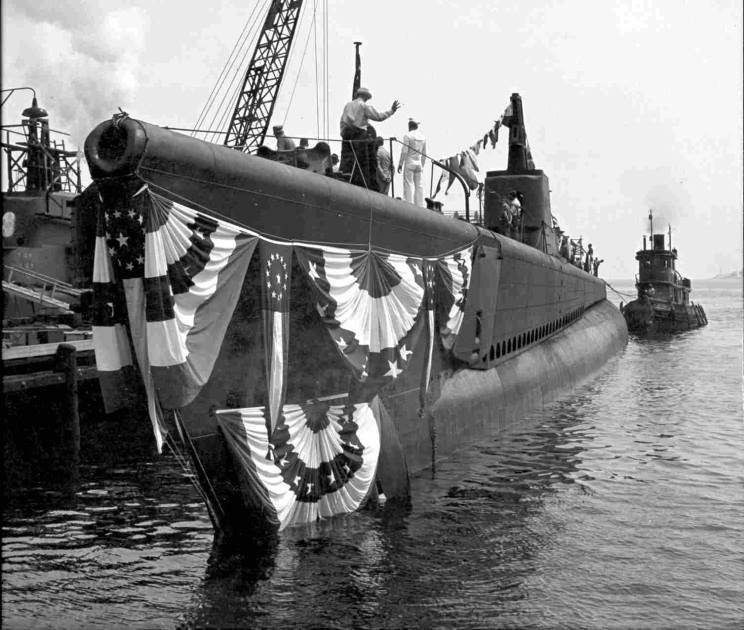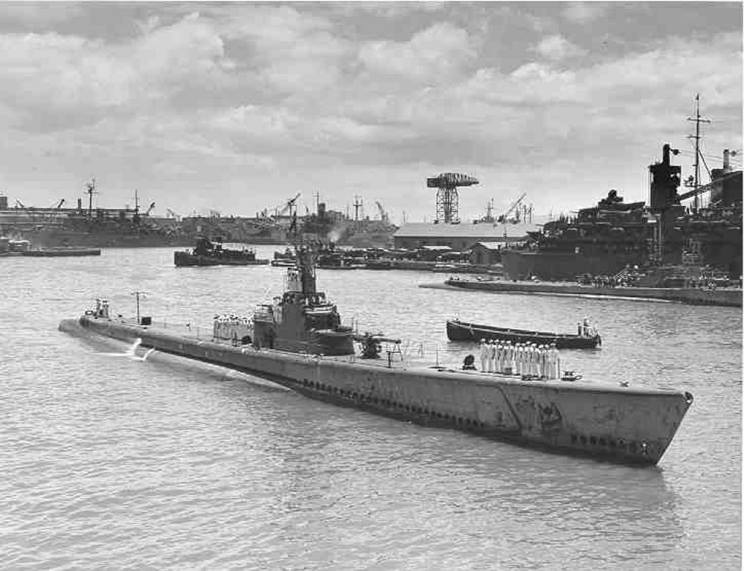|
Built at Electric Boat Company in Groton, Connecticut and commissioned on Armistice Day 1943 under the command of Lt. Commander Eric L. Barr, Jr., USS Bluegill SS-242 would have a productive career. Her first war patrol was begun on April Fool's day 1944, but Barr was no fool to be sure. On Apr. 28th of that year Barr scored his first combat victory when he sank the Japanese cruiser Yubari. Barr skippered Bluegill through all six of her war patrols in World War II. Between the sinking of Yubari and May of 1945 Barr is credited with sending a further 18 ships to the bottom, his total was around 65,000 tons. He was quoted as saying his greatest accomplishment was that "he never lost a man." The last war patrol for Bluegill began from Subic Bay, Philippines on May 11, 1945, he was to patrol the South China Sea. Other than many aircraft sightings (mostly friendly) and destroying two mines on the 19th and the 20th, Barr found no other action. Since he could not find a suitable target on the water, Barr decided to undertake a one boat invasion. On May 26 he had picked up a radar target on Pratas Island, some 190 miles southwest of Hong Kong, he observed the island for the next 12 hours, but saw nothing. He remained off the island even calling in an air strike against towers and buildings on May 28th. Shortly after the air strike, Barr surfaced and fired 136 rounds of 4" and 40mm at the installations. Later the same day they exploded another mine and picked up another radar ping on the island. Just after midnight on May 29, 1945 Barr drew up on the southwest corner of Pratas Island and sent a two man commando force ashore. The men were Capt. Cecil H. Anderson and Lt. Clifford J. Owens, both were from the Australian Imperial Force, who had embarked Bluegill before her sailing from the Philippines. After looking around the ruins they signaled back to Bluegill that the island was clear of enemy troops. While Barr had not seen any movement and received no return fire from the island, it should be noted that the Japanese were quite adept at waiting out a naval bombardment only to emerge and attack when troops had made a landing. Barr and the two Aussies had no real idea if there was anyone on the island or not. The invasion force of one rubber boat and two flo-boats was sent ashore in the morning. The ten men stormed the south jetty and were greeted by the two Aussie commandos. Under the command Lt. George W. Folta, USN the invasion force consisted of (in alphabetical order) MoMM1 Royal A. Bales*, USNR, GM3 Raymon G. Basil*, USNR, Ck3 Homer Dowdell, USNR, Lt. (j.g.) Derwood D. Duncan, USN, Lt (j.g.) Dennis W. Madden, USNR, QM1 Charles H, Maynard*, USN, Coxswain Ennis C. McLaren, USN, MoMM2 Leo G. Rouse, USNR and Lt (j.g.) Frank Stockton, Jr., USNR. (Commissioning crew.) The destroyed buildings and the rest of the island was searched by the 14 man invasion force. Not much of any use was found. The only armament that was located were a pair of dummy guns and two well kept 25mm gus. There was a fuel dump and a small ammo dump found, both were destroyed. Other items were collected including some documents, but they turned out to be only weather reports of some kind. The island had been used by the Japanese as a weather reporting station, but had been evacuated. The men ashore believed there had been nobody on the island for a fortnight or more. At 1022 hours (another report states 1122 hours) a ceremony was held and the American flag was raised, now in possession of the United States, Pratas Island was renamed Bluegill Island. A plaque was affixed to the flagpole and the invasion of Pratas Island was complete, the United States Navy (with the help of two Australians) had successfully captured the island. Vice Admiral Charles A. Lockwood, Commander Submarines Pacific, later wrote that Cdr. Barr had sent a request for "invasion" medals for the landing force. This may be the only instance of a U.S. submarine single handedly capturing an entire island. The raiders returned to Bluegill at 1640 hours and went on to the next assignment to act as lifeguard boat southwest of Takao, Formosa. Bluegill remained in the area until June 6, when she was relieved by Icefish SS-367. Barr, Bluegill and his men began the long trip home at 0555 on that day. They exploded another mine on the 7th and arrived at Saipan on June 12th. The next day they set sail for Pearl Harbor. They arrived at Submarine Base, Pearl Harbor on June 21st. For the men of Bluegill their war service was over. Commander Barr continued to serve in the navy and retired as a Captain (like his father before him) on Mar. 1, 1947. For his service in Bluegill and earlier in Kingfish SS-234 he had earned the Navy Cross with a Gold Star, Silver Star with a Gold Star (Gold Stars in lieu of a second award), Bronze Star, 8 Submarine Combat Awards, Navy Commendation Medal, Navy Unit Commendation and the Philippine Presidential Unit Citation. Barr spent the next 17 years working at Electric Boat and General Dynamics, building submarines. He later went into the oil business and worked for many major oil companies around the world. In 1982 he settled in San Antonio, Texas and remained there until his death on Aug. 16, 2010 at the age of 98. He is buried at Arlington National Cemetery. USS Bluegill was decommissioned and recommissioned several times undergoing several major alterations and remained in service until her final decommissioning on June 28, 1969. The boat was scuttled off Hawaii on December 3rd of 1970. |
© 2017 Michael W. Pocock MaritimeQuest.com |
 |
On this Memorial Day of 2017 we honor all service personnel who sacrificed their lives for our country. We also honor such men as Eric Barr and those who served with him. God Bless those who serve and those who gave all in service. |
 |
August 8, 1943: Launch of Bluegill SS-242 at Electric Boat Company, Groton, Connecticut. |
 |
June 21, 1945: USS Bluegill SS-242 arriving at Submarine Base, Pearl Harbor, Hawaii following her sixth war patrol. |